Valašský Frgál is a sweet Czech specialty made nowhere else in the world. Wallachian frgál tastes a bit like butter and smells like rum and could be filled with pears, tvaroh cheese, poppy seeds, plum butter, blueberries, and other fruit fillings.
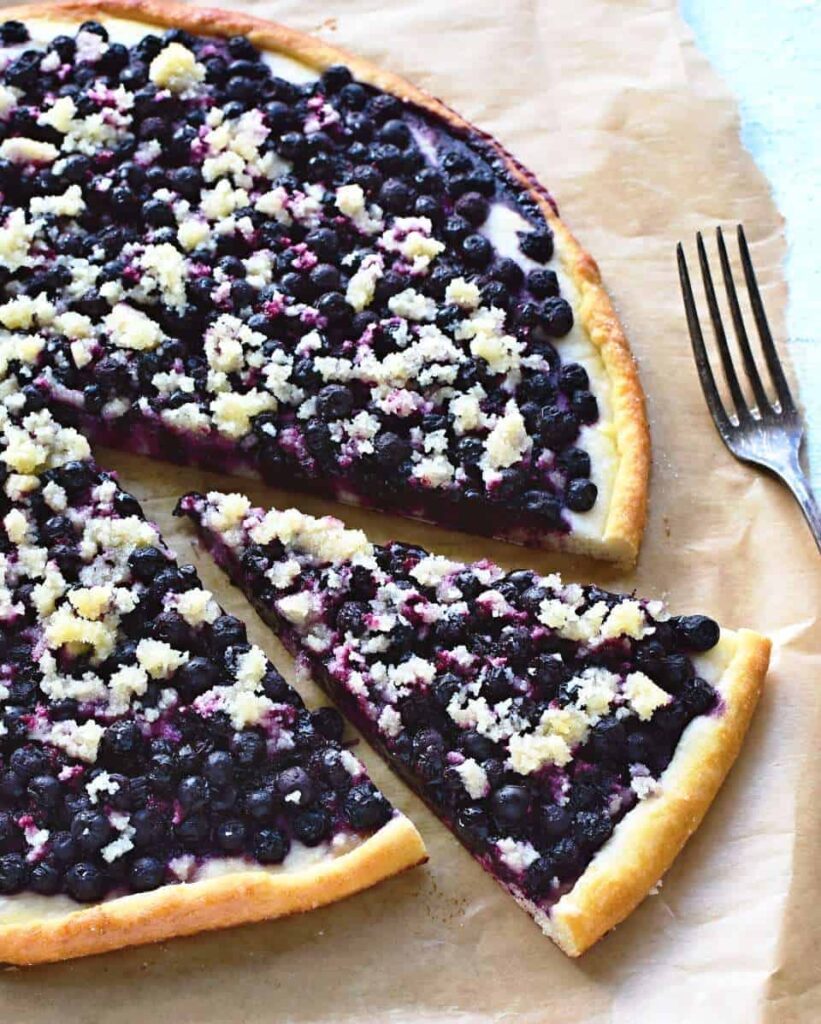
➜ What Is Wallachian Frgál?
Frgál is a special kind of kolach, made from thinly rolled out yeasted dough filled with sweet fillings. The streusel topping is sprinkled on top, called „posypka“ in Wallachia.
Commonly, the filling and streusel layer are taller than the dough itself. After taking frgál out of the oven, the surface is splashed with butter mixed with spiced rum (in Czech "tuzemák").
Frgál is round, about 12 inches (30 cm) in diameter, and is traditionally baked in an Eastern Moravian region known as Valašsko (Wallachia).
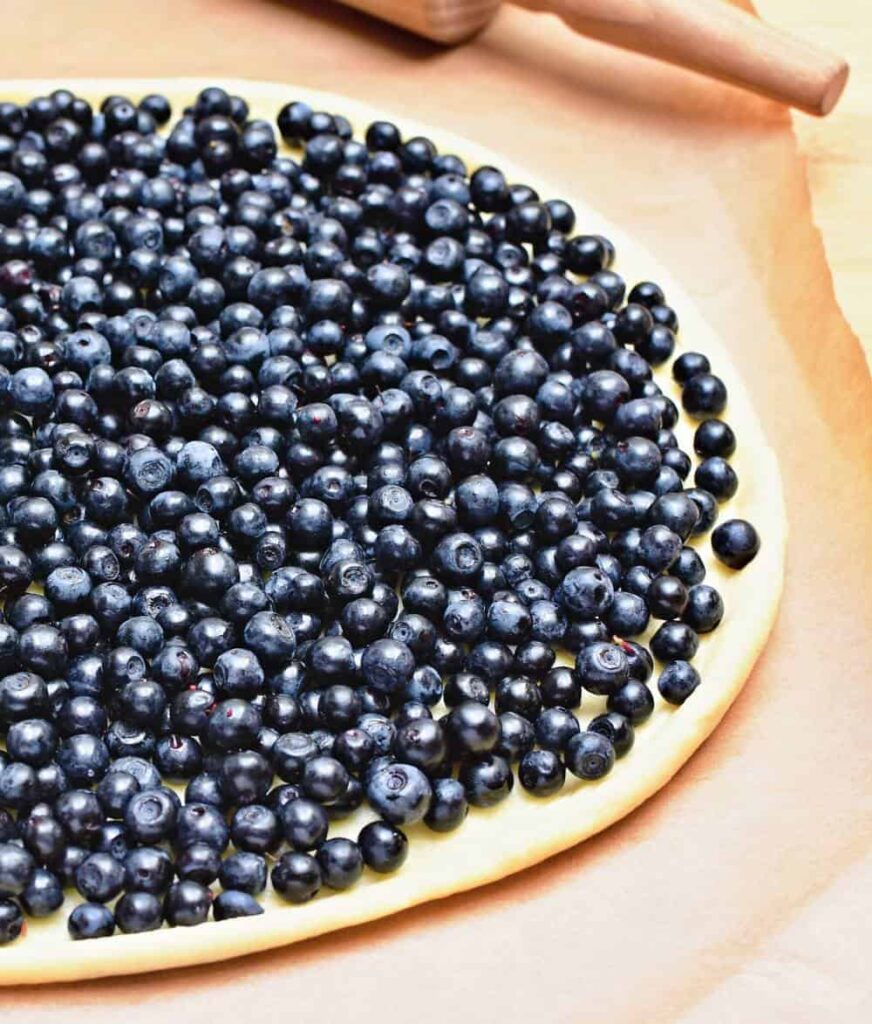
➜ Origin of Frgál
Like so many other delicacies that have dominated the culinary world, frgal was originally a mistake.
When a clumsy baker failed at making kolach, she got angry and called it an frgál, a word in the Wallachian dialect used to represent flawed products.
Other names for this sweet pastry include „lopaťák“ or „pecák“.
Lopaťák comes from the Czech word lopata (shovel), which means a kolach sized as a shovel. Pecák comes from the word pec (wood-fired oven) used to bake pies and other pastries.
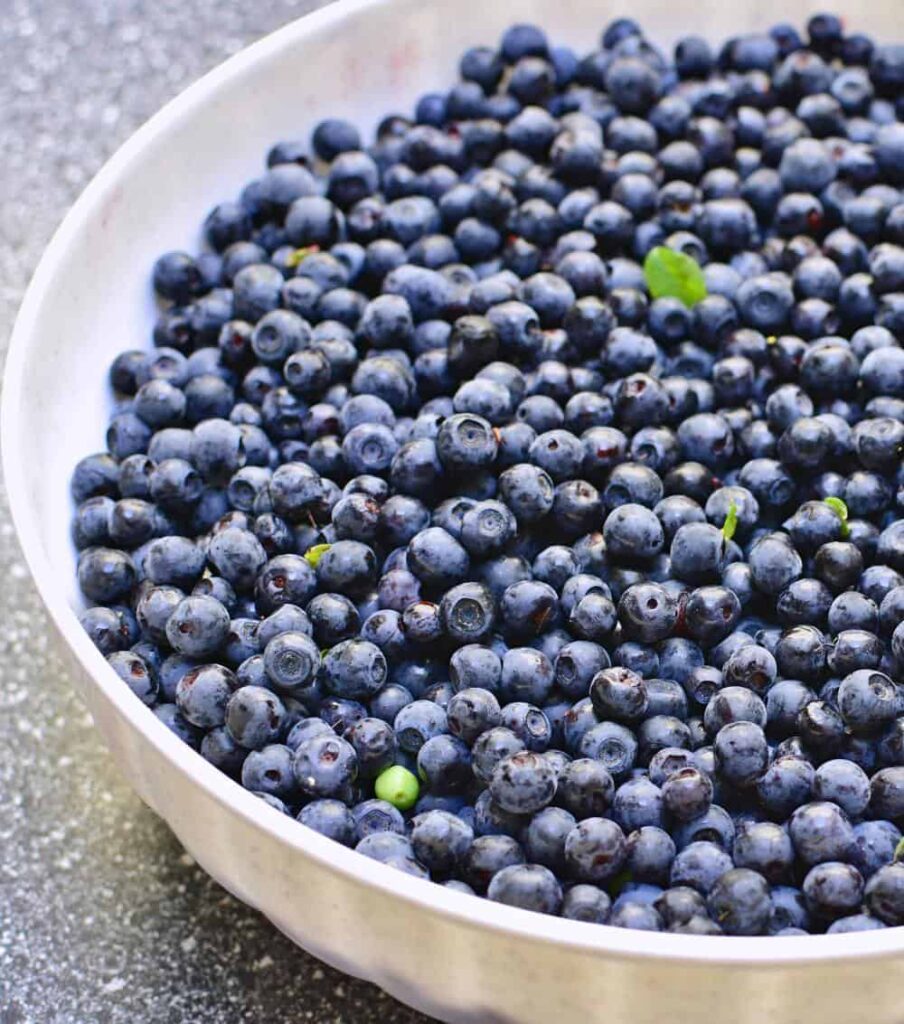
➜ Yeast Dough
Frgál is prepared from the raised dough, which is rich in fat, so it takes longer than other doughs to rise. Yeast dough for frgál takes at least an hour and a half to get ripe enough.
Before leavening, split the dough into two buns. Each will be about ¾ pound (330 g) in weight, which is how much you need for a single frgál.
Place the raised dough on baking paper and roll it out into a thin 12-inch circle. Lift the edge a little to prevent the filling from spilling out while baking.
⤍ Learn how to make dough rise in the oven.
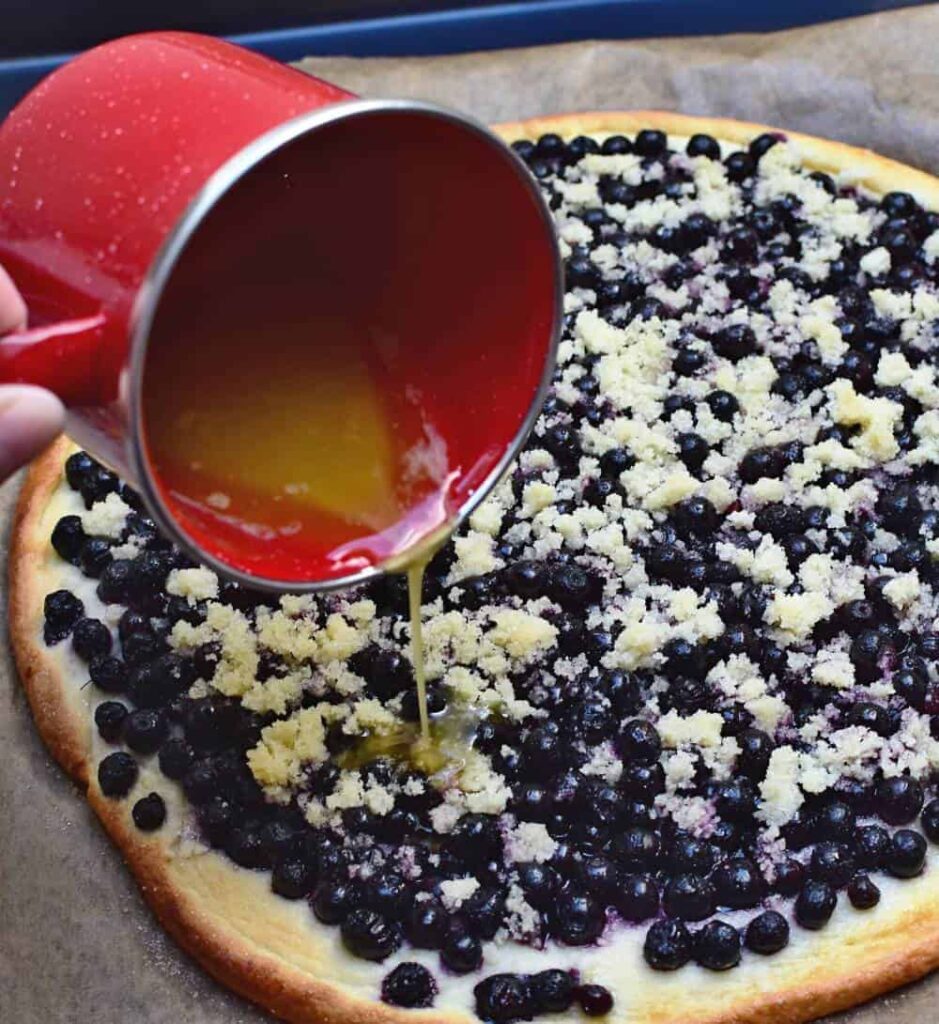
➜ Filling
Frgály pastries are most commonly filled with jam made from dried pears, plum butter, poppy seeds, or quark (tvaroh cheese). There are other options to fill the frgály, such as blueberries.
Since I live on the edge of the Jizera Mountains, I'm used to picking fresh wild blueberries when they are in season. A plethora of blueberries ripen in the nearby woods at the end of June and throughout July! That's also why I used blueberries to fill the frgal.
➜ Pronunciation
I recorded a short audio clip on pronouncing the Czech word frgál. The first word in the audio is "frgál", and the last is "valašský frgál", which means Wallachian frgál.
More Czech desserts:
- Buchtičky s vanilkovým krémem – small yeasted buns with vanilla sauce
- Míša řezy – Czech black & white sheet cake
- Czech kolache – authentic recipe for kolaches
- Yeast coffee cake – with blueberries
Tried this recipe?
Leave a review down in the comments! ⭐⭐⭐⭐⭐
Follow me on Facebook and Pinterest. Subscribe to my newsletter. Send me any question about Czech cuisine to my e-mail. I love hearing your feedback!

Wallachian Frgál with Blueberries
Ingredients
Yeasted dough for 2 frgály:
- 2 and ⅔ cups all-purpose flour (350 g)
- ½ cup milk (120 ml) lukewarm
- 2 teaspoons active dry yeast or 30 g fresh yeast
- ¾ stick unsalted butter (85 g)
- 1 egg yolk
- ⅔ cup powdered sugar (80 g)
- pinch of salt
- 1 Tablespoon lemon zest grated from 1/2 lemon
Streusel:
- 1 and ¼ stick unsalted butter (140 g)
- ¾ cup (140 g) granulated sugar
- 1 and ¼ cups (160 g) all-purpose flour
Filling:
- 3 cups fresh blueberries
- 4 Tablespoons granulated sugar to sweeten blueberries
Butter mixture:
- 1 and ½ sticks unsalted butter (170 g)
- 3 Tbsp spiced rum
Plus, you’ll need:
- 1 egg beaten, to brush edges of frgál
Instructions
- Sift flour into a mixing bowl, and make a little well in the middle. Pour 2/3 of the warm milk, a spoon of sugar, and yeast in it. Mix the middle with a fork, add some flour from the sides. Cover with a kitchen towel and let it rise for 30 minutes in a warm place.
- Melt the butter in a small pot, add it to a bowl with flour and yeast (the butter must be warm, not hot!).
- Add the rest of the lukewarm milk, sugar, an egg yolk a pinch of salt, and grated lemon zest.
- First, mix the dough with a fork, then knead with your hands or in a kitchen robot for about 10 minutes. The dough should be non-sticky and smooth. Add some flour if the dough is too sticky while kneading.
- Split the finished dough into two buns, cover with a clean towel and let it rise for 1,5 hours in a warm place.
- Meanwhile, prepare the streusel – mix the sugar, flour, and butter and form the streusel using your fingers.
- Place the leavened bun on baking paper and roll it out into a circle about 12 inches (30 cm) in diameter. If the dough sticks, you can sprinkle the baking paper with a little flour.
- Around the edges, make a small rim and roll it in. You will use up about 1/2-1 inch (1-2.5 cm) of the dough edge.
- Brush the edge of the dough with a beaten egg.
- Place blueberries evenly on the dough, and sweeten them with sugar to your liking. How much sugar you pour over fruit depends on the sourness of blueberries. Usually, two tablespoons of granulated sugar per frgal is enough.
- Sprinkle with streusel liberally and let the frgál rise for 15 minutes.
- Transfer the frgál with baking paper carefully on a baking tray and bake it in the preheated oven to 340 °C (170 °C) for 20 minutes.
- Melt the butter for final splashing in a pot and mix it with rum.
- Once you take the frgál out of the oven, splash its surface with the butter & rum mixture.
- Bake the 2nd frgál as described above.
Notes
- The recipe makes two frgál pieces in size 12 inches
- Please remember to divide the streusel/filling/splashing in two while making frgály (I mean not to splash one frgál with all butter&rum mixture).
- The edge of the frgál is finished before the center is done. That’s because a layer of streusel and filling covers the center, and it takes longer for it to get baked. Take care, so the rims aren’t golden brown, but the center is still raw. Hold on to baking the frgál for 20 minutes. However, if you notice the edges browning too quickly, loosely cover the frgál with aluminum foil.
DISCLAIMER: Because I come from Central Europe, my recipes are based on metric units such as grams or milliliters. Check out how I convert metric units to the U.S. system:
Conversion chartNutritional Estimate pro portion
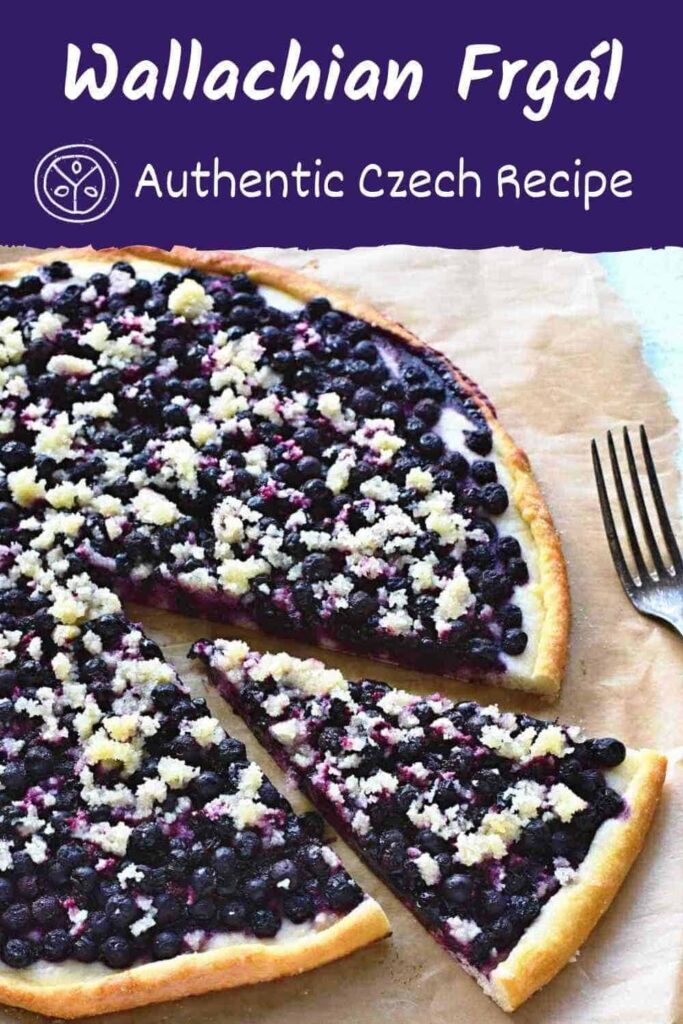



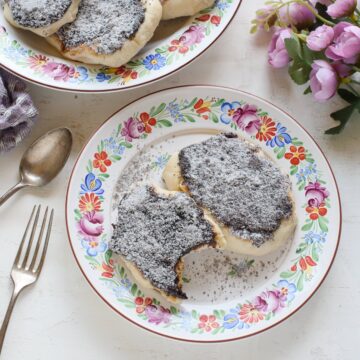
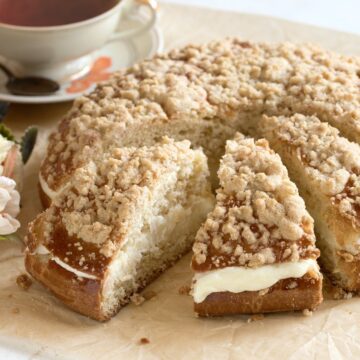
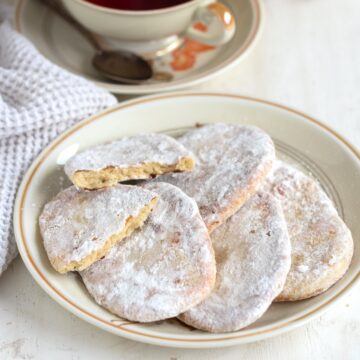
Matt Erdman
Hello Petra,
My mother's family immigrated to the United States from what is now Czechoslovakia in the 1800's. We still have family in Bílov. When I was young, my grandmother made frygály, which she called kolache. Since she passed away in the nineties, I've continued to make these traditional desserts for my family on holidays, but I've never been able to get the crust right; it always rises too much or too little. Thank you for posting your recipe. Every year there is more information online, and that's how I found out that this style of pastry is called a frygál. With help from you and others, I will eventually make this dessert as well as my grandma did.
Best of luck with your online venture!
-Matt
Petra | Cook Like Czechs
Ahoj Matt,
thank you very much for you comment, as I checked Bílov is a nice town in the North Moravia. Have you ever been there?
Once I had a holiday near there with my family and the surrounding is pretty impressive – both wonderful nature and industrial feeling (Ostrava above all). Especially my boys loved it! 🙂
About frgály: This is a specialty of Moravian housewives, we in the Bohemian part of the Czech Republic can only be envious. We only make kolaches here, which are smaller and not so „rum-smelling“ like a real frgál.
Frgál is bigger than the normal kolach and is about 12 inches in diameter. The dough is very thin, but there is plenty of filling on it.
Crossing my fingers that your next try will turn out exactly how your grandmother used to bake.
Enjoy your Christmas time,
many greetings from the Czech Republic, Petra 🙂
Beck
Petra, I am going to make this on the recommendation of a Czech friend from the Olomouc area. What would be the best oven temperature to make sure the dough cooks evenly on the edges and under the filling?
Děkuji!
Petra
Hello Beck, thank you for your comment! The temperature in the oven for frgál is just fine about 340 °F (170 °C), I added this important detail to the recipe (I’m sorry I omitted this information). I also added a note on browning the edges of frgál while it is baking: "However, if you notice the edges browning too quickly, loosely cover the frgál with aluminum foil." Written at the bottom of the recipe. Please, don’t forget to splash the frgál liberally with the butter&rum mixture immediately after taking the cake out of the oven, this is where the magic lies. Wishing you lot of success with Wallachian Frgál, dobrou chuť and many greeting from the Czech Republic, Petra
Anthony Machacek
Just you know, Valacien frugal is not made with blueberries but with dry pears filling
Petra Kupská
Ahoj Anthony, thank you for your comment. You are right, Wallachian frgals are often filled with dried pears (called pracharanda in Czech). However, it is not the only type of frgal-filling. Poppy seed, tvaroh (farmers’ cheese), and plum fillings are also popular. Blueberries are less common, but they are certainly one of the fruits that can be used. It also depends on the region where the frgals are baked and the season - fresh wild blueberries can be picked until about mid-summer when they grow abundantly in the Czech forests.
Cherry Chapman
Hello Petra!
Bravo, and thank you for your excellent recipes and your son for his wonderful English translations!
I am an American living in Paris, France who loves to try different recipes from various countries.
I look forward to trying the Frgály as splashing the tart with butter and rum sounds unusual and delicious.
Easter Blessings to you and your family.
Petra Kupská
Ahoj Cherry, thank you very much for your lovely comment! 🙂 Frgals are an excellent choice. They taste delicious, and besides blueberries, frgaly cakes can be filled with poppy seeds, thick pear jam, or cream cheese filling. The trick to drizzle them right out of the oven with melted butter mixed with rum is brilliant. I also use this method for small wedding cookies: I dip them still hot in a mixture of butter and rum and quickly coat them in icing sugar. Give it a try and I'll love it if you let me know how it turns out! Best wishes to Paris from Bohemia, Petra
Monica Frydl
Petra,
In the ingredients list, there is yolk. However I noticed that it is not mentioned in the cooking instructions. Later the instructions say to use an egg to brush the dough, is this where you use the yolk?
Petra Kupská
Ahoj Monica, thank you very much for your sharp eye! The egg yolk is added to the yeast dough when made, I forgot to mention that in the instructions. I immediately corrected it in point 3. Thanks again for your remark!
Kimberly
Hello
I would like to try making this. When you make the strudel mix, should the butter be cold or room temperature?
Anicka Cooklikeczechs.com
I make streusel topping or posypka with butter that I take out of the fridge a little while before preparation. It's not cold, but it's not at room temperature either.
Ray
aye good day Petra I really enjoy your recipes I live in Tennessee in the USA have some knowledge of polish recipes and a lot of southern cooking experience I see similarities with your formulas and polish recipes I grow a lot of my food here on homestead so I cook with what I have on this recipe I used the homemade blueberry pie filling that I canned because that is what I have in my pantry it was excellent I rolled out the dough with a large lip as to hold my filling and topped with the strudel after baking and put back in the oven to brown I am planning on freezing more of my blueberries harvest this year but im limited on freezer space again thanks for sharing your time and recipes 👍👍👍👍👍👋🙏
Petra Kupská
Thank you, Ray, for your nice comment! The cuisines of the Czech Republic and Poland have a lot in common, plus both countries are also neighbors 🙂